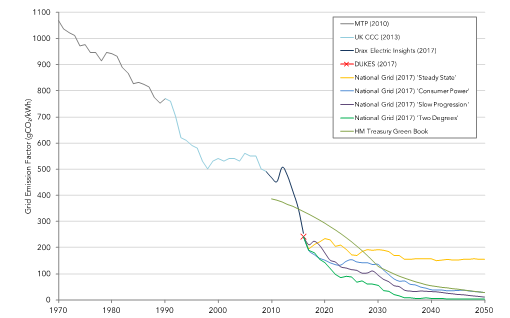Intro
Many energy wonks in the industry like me are currently contemplating The Future Homes Standard Consultation, and considering how best to respond. There is a multitude of important issues to consider in the proposals such as omitting the FEEs criterion (in my opinion, bad) and the Accredited Construction details (basically good), introducing Primary Energy (fine but not like this), and removing the power for Local Authorities to impose energy, carbon and sustainability targets through planning (bad). I am working with our local AECB group to put together a response, and comparing notes with various other respondees so will be developing more detailed responses in due course; for this piece I wanted to share a high level perspective that is effectively a golden thread running through most of my thinking, not just with respect to this consultation but all the work we do at Greengauge.
Big picture
One thing that the consultation documents make abundantly clear is that the vast majority of space heating will in the future be derived from electricity. Great strides have been made in renewable energy in the last decade or so; wind and solar now make significant contributions to our energy mix. On top of this, power from coal fired power stations has reduced via decommissioning and substituting in biomass (a controversial topic beyond the scope of this blog). This is all generally good news, and has lead to a significant de-carbonisation of our electricity supply, and projections indicate the trend will continue. The best representation of this is the graph our friends at Etude produced as part of their heat pump report for the Greater London Authority last year.

This heat can be converted from electricity by either direct electric (simple and cheap to install, but expensive to run), or via heat pumps of one flavour or another. Heat pumps leverage the electrical energy by absorbing ambient heat from the air or ground, so you get out two or three times as much energy as you put in as electricity.
This sounds like a great solution – increasingly clean, renewable electricity to spin heat pumps for efficient, low-carbon heat; what’s not to like? Unfortunately, this is a dramatic, and arguably dangerous over-simplification. What is even more unfortunate, this oversimplification is hard-wired into our building regulations.
The problem is two-fold – capacity and timing. We will need to generate an order of magnitude more renewable electricity to enable wholesale heatpumpification; what would ten times the number of solar fields and wind farms be like? But that’s the easy bit; technically speaking, its just a question of scale. What’s more challenging is the intermittent nature of most of our renewable energy, and the fact it’s driven by the weather, and cannot be ramped up and down according to demand as can fossil fuelled power stations. Other technologies are of course already playing a role, in particular nuclear, but again less important to this argument.
Numbers – how much energy and power
If you’re not already aware of the fantastic UK Energy Flow Chart, do go and take a look.

Apart from being a great piece of graphic design worthy of the ‘data is beautiful’ award, it contains a phenomenal amount of incredibly useful information. For example, we can see that UK homes consumed about 41 MTOe of energy last year. This includes stuff other than heating (cooking, lighting, appliances etc), but still about two thirds was from gas; most of the remainder was electricity. The other side of the graph shows us we generated 6.5 MTOe from hydro, wind and solar. Personally, I have reservations about biomass energy so am not considering that here. So immediately we can see our generation has a long way to go, and that’s before we consider that the electrification of transport, and other sectors.
The Passivhaus Trust have done a simple back of the envelope calculation to show a similar problem with respect to peak power capacity (as opposed to energy): 25 Million homes, fitted with a 15kW heat pump with a (optimistic) SCOP of 3 gives 125 GW of demand; the diversity factor might bring this down by, generously speaking, one half, so 63 GW. The current national generation capacity is somewhere between 60 and 75 GW, depending how it’s defined and what safety margins are allowed for. Again, electric cars and other sectors must be considered, and again, this suggests that dramatic changes would be required to our infrastructure to enable such a change.
The other major problem is one of timing. Our current power system was designed around demand response generation. Base load is made up with Nuclear (which is hard to turn on and off at all, let alone quickly), and to a lesser extent, coal (which can ramp up and down but not very quickly). Until recently, the rapid fluctuations in demand were accounted for with gas generation which can ramp up and down very quickly. Demand famously increases sharply at the end of certain soap opera broadcasts when everyone puts the kettle on for the post-Corri-cuppa – all possible because of gas turbine power. Solar, wind and to a lesser extent, hydro, cannot be controlled – you just get what you’re given by the weather. Gas has perhaps ironically facilitated large scale solar and wind installations by providing generation flexibility; when a storm blows the turbines round faster or a sunny day boosts solar production, the gas eases of, and vice versa. The supply can be predicted to some extent – it’s sunnier in the summer and a bit more windy in the winter, but the basic issue is that the supply often comes at a different time to the demand.
Rule of thirds
I’ve devised another simple calculation to get a basic feel for the order of magnitude of this issue. Let’s say, in the bright, green future, all electricity is renewable, principally wind and solar. Let’s make a bold guess, and say that of all the energy supply (and demand, including inefficiencies) about one third can be used instantaneously; a joule is generated from a PV panel and it goes straight down some wires and into a kettle. All you need is enough renewables.
Now let’s say the next third is generated a bit out of sync with demand and needs to be stored for maybe two to four days, to account for fluctuations in the national weather. This is the sort of thing that technology like the Tesla Powerwall might be able to address. Let’s just check the numbers for that. If we divide our 41 MTOe national domestic demand by three and convert the units we get 160 TWh annually. Say that we want to be able to store 3 days’ worth of energy to carry a house through a calm, overcast period of weather. That’s 3 out of 365, a little under 1% of annual demand, so 1.6 TWh. The current Powerwall can store 13.5 kWh, so you’d need 120 Million of them to store that energy – about five per house. So quite a lot, but within the realms of possibility, particularly if other storage technologies are considered, for example compressed air. But the latter technology is in its infancy, and five powerwalls per house would come in at £25000 at current prices.
Our final third is energy that must be stored inter-seasonally. The only viable technologies for this are Synthetic Natura Gas or Hydrogen, which can be created via electrolysis powered by renewables during times of excess supply. Storing 160TWh would require generating, storing and re-distributing 14 x 1010 m3 of gas, or about 100000 gasometers worth. This volume could be reduced by compressing the gas (which requires energy) and it may be possible to store the synthetic gas in reservoirs which we have emptied of natural gas and oil.
These numbers could be a fair way out – they are very much back-of-the envelope, and do not account for, for example the benefit of heat pumps. We could be talking about a mere 10000 gasometers, or maybe more like 10 powerwalls per house; but whichever way you cut it, the scale of the problem is enormous, and current policy proposals do not even mention it. A little could be gained by demand-response, i.e. delaying or advancing the use of flexible energy uses such as in fridges and freezers, if the temperatures are allowed to fluctuate slightly. But there’s one approach that is comparatively cheap, and has a host of co-benefits: efficiency.
If we can dramatically reduce the energy consumption of our homes, via fabric efficiency, both new build and, crucially, the existing stock, all of the numbers above scale down accordingly, and become much more feasible from a technical and economic point of view. We must start working on radical energy efficiency as a matter of urgency and priority.
Conclusions
Electrification is necessary, but not sufficient condition for de-carbonisation. Although the significant advances in renewable generation are important and to be celebrated, we must bring forward the development of technology to store vast amounts of energy for very long periods of time – months rather than hours. Heatpumpification is necessary but not sufficient condition for decarbonisation; heat pump undoubtedly will play a major role in the way we heat our buildings in the not so far future. But even simply building the necessary supply chains is a major undertaking. Fabric efficiency is essential to reduce the scale of the challenge of supply and storage to levels that are economically and technically feasible. And this is why the proposals set out in the future homes consultation are simply inadequate. It no longer makes sense (if it ever did) to consider buildings as carbon- and energy-islands, which plug into a battery called the grid. National policy must look at the entire energy system holistically, including sources, distribution, storage (at a variety of scales and locations), and, critically usage. Ironically, the lower the grid carbon factor, the less suitable building CO2 emissions are as a metric for incentivising the creation of a low-carbon, sustainable energy system.





